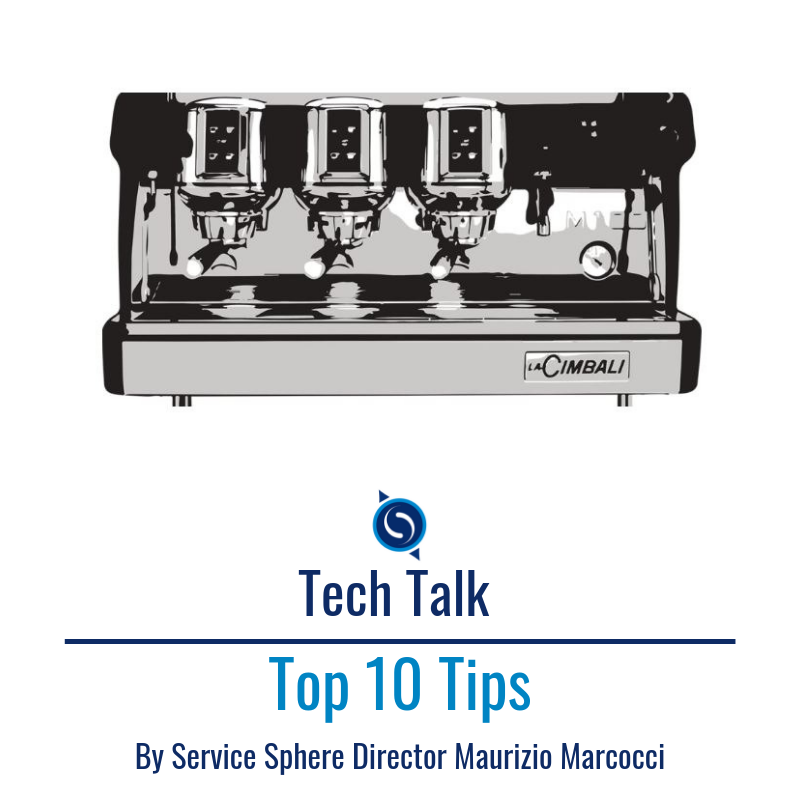Tech Talk - Top 10 Tips for Healthy Espresso EquipmentBy servicesphere.com.au20 Aug, 2019 There’s no great time for your machine to break down, and there’s no convenient time for a preventative maintenance check-up, but regular appointments based on your volume of usage or yearly cycle will help prevent any unwarranted phone calls from your machine technician with a preventable illness or worse, a terminal outlook. Before we get to that sorry state, there are plenty of easy tricks café owners and baristas can do on a daily basis to have espresso machines functioning at 100 per cent and delivering espressos with the taste profile they’re intended to produce. If you get into these habits early they won’t feel like chores but regular steps in your daily cleaning routine. 1. Coffee puck removal It is imperative to remove the coffee puck after each brew. This will prevent the oils from retaining on the showers, not to mention a better tasting coffee. Rather than putting the puck in the bin, consider recycling it as compost in your garden or donating it to a company that collects spent grounds to make cosmetic products. I suggest purging the group head for three to five seconds before making the next coffee to ensure the next shot is brewed with fresh water and no loose granules make their way into your cup. 2. Group handle cleaning Soak group handles and filters in 500 millilitres of hot water with two scoops of espresso machine cleaner for no longer than 10 minutes. Remember not to soak the plastic components of the handle and never place them in the dishwasher. Follow packet instructions carefully if in doubt. Before use, rinse the group handles thoroughly in running hot water and produce a blind shot before continuing regular espresso production. If you don’t regularly clean your accessories, oils will build up and coat the group handle, leaving a bitter taste. 3. Clean shower screens Wipe the shower screen with a cloth before purging water through the group head between shots. This will create a more consistent water displacement for which the shower screen is intended. It will eliminate coffee grind build-up and any oils left behind. If you don’t clean the shower screens regularly, your espressos will start to taste unreasonably bitter. 4. Back wash Back flush your machine every day. Using an espresso machine cleaner, place a table or cleaning agent into a blind filter and follow instructions to back wash your machine to remove oil remnants. This process forces water and cleaner back through the systems over the pressure valve and flushes out any nasties. You’ll be amazed at the dark oils your machine excretes. Regular back washing helps ensure your machine is performing at its peak, and your coffee tasting its best. I suggest discarding the first coffee you make after this process to ensure all remnants of chemicals are correctly flushed out of the system. 5. Steam wand purge In most Australian cafés, the steam wand gets a decent workout every day. Considering that more than 90 per cent of coffee orders are milk-based, from full cream to skinny milk, almond to soy, it’s important to take care of this overworked arm. Prior to texturing your dairy or alternative milk, purge the steam arm and let the hot water remove any stale or leftover milk residue built-up in the tip of the nozzle. After texturing, clean the end of the wand with a cloth and purge the steam arm again for a few seconds. Close the steam valve and then wait about three seconds before repeating. A helpful tip is to have a separate coloured cloth for each aspect of cleaning: one for the group handle, one for the steam arm, and one for general cleaning around the machine. There are some great steam wand cleaners in the market that also assist in the sanitisation and prevention of milk solid build up. Generally, it involves adding a cleaning agent to water and flushing out the steam arm to remove milk build-up. Once you have completed the process you should rinse and flush the steam wand thoroughly before use. 6. Use all components of your espresso machine It might sound obvious but technicians fitted espresso machines with two steam arms for a reason. If you’re like me, I take a preference to a particular side for no obvious reason, and I know I’m not alone. It’s intriguing to see how many baristas use the one steam arm during service, but it’s OK to rotate sides, you might even find a new favourite. Alternating between each steam arm ensures high steam pressures are constant. The metals do expand and therefore you will lose a little pressure. It also prevents the general wear and tear on one arm alone, and helps prolong the life of your steam taps. 7. Clean drip tray It’s often an afterthought, but cleaning your drip tray regularly will prevent the build-up of coffee particles. Wipe away the residual coffee granules with a cloth opposed to flushing them down the machine’s drain to prevent the drain line from blocking. After service, it doesn’t hurt to pour a litre or two of hot water down the drip tray to also prevent the drain and wastage hose from blocking. 8. Save energy To turn a machine off or leave it on, that is the question – and a common one from baristas at that. To determine the right answer, let’s split this topic into two parts. First, turn your home machine on at least half an hour prior use. This will enable all components of your espresso machine to be heated up and allow you to begin brewing your coffee. In the event you do not allow all the components to be heated, you will experience poor in-cup quality. Once you have decided to not use your machine and you have had your caffeine fix, then you can turn it off. If you are running a café, your espresso machine should be turned on at least one hour prior to service to enable all components to be at its optimum, or left on at all times during working hours and switched off during non-working hours. It is good practice to have a routine to allow your machine to be turned off and reduce the risk of wear and tear. Some machine models have energy-saving features, but generally, an espresso machine uses less energy when idle but still left on. Whatever your preferred method of turning your machine ‘off’ or ‘on’, just keep your routine consistent. 9. Exterior clean Not only does regular cleaning of a coffee machine’s exterior avoid rust development, it keeps it in a presentable manner to impress each customer as they walk through the café door. Investment in an appropriate surface cleaner is a must and will have your machine looking a million bucks. 10. Routine check up On a six-monthly or annual basis (depending on your weekly use/volume), book your espresso machine in for a service. At Service Sphere, we recommend having your machine looked at by a qualified service technician to give your machine a once over and ensure all your components are in best working condition. The process will generally take up to 1.5 hours but it will improve the equipment reliability, decrease the cost of replacement or life of equipment, decrease downtime, and increase customer satisfaction. Long-term effects and cost comparisons usually favour preventative maintenance over reactive maintenance so don’t wait for your machine to be out of order before you book your service. Just as health experts recommend mental health is just as important as physical health, follow the above tips to ensure your machine is content from the inside out, and can deliver a delicious product for years to come. After all, a clean each day will keep the doctor away."> Maurizio Marcocci of Service Sphere addresses preventative treatments to avoid an unnecessary trip to the doctor and keep espresso shots tasting on point.Winter has a knack for unleashing the most annoying sickness: cold, coughs and flu. Some are contagious and some are preventable (flu shot anyone?) but no matter what the outcome, nobody has time to be sick, and that applies to your coffee machinery. There’s no great time for your machine to break down, and there’s no convenient time for a preventative maintenance check-up, but regular appointments based on your volume of usage or yearly cycle will help prevent any unwarranted phone calls from your machine technician with a preventable illness or worse, a terminal outlook. Before we get to that sorry state, there are plenty of easy tricks café owners and baristas can do on a daily basis to have espresso machines functioning at 100 per cent and delivering espressos with the taste profile they’re intended to produce. If you get into these habits early they won’t feel like chores but regular steps in your daily cleaning routine. 1. Coffee puck removal It is imperative to remove the coffee puck after each brew. This will prevent the oils from retaining on the showers, not to mention a better tasting coffee. Rather than putting the puck in the bin, consider recycling it as compost in your garden or donating it to a company that collects spent grounds to make cosmetic products. I suggest purging the group head for three to five seconds before making the next coffee to ensure the next shot is brewed with fresh water and no loose granules make their way into your cup. 2. Group handle cleaning Soak group handles and filters in 500 millilitres of hot water with two scoops of espresso machine cleaner for no longer than 10 minutes. Remember not to soak the plastic components of the handle and never place them in the dishwasher. Follow packet instructions carefully if in doubt. Before use, rinse the group handles thoroughly in running hot water and produce a blind shot before continuing regular espresso production. If you don’t regularly clean your accessories, oils will build up and coat the group handle, leaving a bitter taste. 3. Clean shower screens Wipe the shower screen with a cloth before purging water through the group head between shots. This will create a more consistent water displacement for which the shower screen is intended. It will eliminate coffee grind build-up and any oils left behind. If you don’t clean the shower screens regularly, your espressos will start to taste unreasonably bitter. 4. Back wash Back flush your machine every day. Using an espresso machine cleaner, place a table or cleaning agent into a blind filter and follow instructions to back wash your machine to remove oil remnants. This process forces water and cleaner back through the systems over the pressure valve and flushes out any nasties. You’ll be amazed at the dark oils your machine excretes. Regular back washing helps ensure your machine is performing at its peak, and your coffee tasting its best. I suggest discarding the first coffee you make after this process to ensure all remnants of chemicals are correctly flushed out of the system. 5. Steam wand purge In most Australian cafés, the steam wand gets a decent workout every day. Considering that more than 90 per cent of coffee orders are milk-based, from full cream to skinny milk, almond to soy, it’s important to take care of this overworked arm. Prior to texturing your dairy or alternative milk, purge the steam arm and let the hot water remove any stale or leftover milk residue built-up in the tip of the nozzle. After texturing, clean the end of the wand with a cloth and purge the steam arm again for a few seconds. Close the steam valve and then wait about three seconds before repeating. A helpful tip is to have a separate coloured cloth for each aspect of cleaning: one for the group handle, one for the steam arm, and one for general cleaning around the machine. There are some great steam wand cleaners in the market that also assist in the sanitisation and prevention of milk solid build up. Generally, it involves adding a cleaning agent to water and flushing out the steam arm to remove milk build-up. Once you have completed the process you should rinse and flush the steam wand thoroughly before use. 6. Use all components of your espresso machine It might sound obvious but technicians fitted espresso machines with two steam arms for a reason. If you’re like me, I take a preference to a particular side for no obvious reason, and I know I’m not alone. It’s intriguing to see how many baristas use the one steam arm during service, but it’s OK to rotate sides, you might even find a new favourite. Alternating between each steam arm ensures high steam pressures are constant. The metals do expand and therefore you will lose a little pressure. It also prevents the general wear and tear on one arm alone, and helps prolong the life of your steam taps. 7. Clean drip tray It’s often an afterthought, but cleaning your drip tray regularly will prevent the build-up of coffee particles. Wipe away the residual coffee granules with a cloth opposed to flushing them down the machine’s drain to prevent the drain line from blocking. After service, it doesn’t hurt to pour a litre or two of hot water down the drip tray to also prevent the drain and wastage hose from blocking. 8. Save energy To turn a machine off or leave it on, that is the question – and a common one from baristas at that. To determine the right answer, let’s split this topic into two parts. First, turn your home machine on at least half an hour prior use. This will enable all components of your espresso machine to be heated up and allow you to begin brewing your coffee. In the event you do not allow all the components to be heated, you will experience poor in-cup quality. Once you have decided to not use your machine and you have had your caffeine fix, then you can turn it off. If you are running a café, your espresso machine should be turned on at least one hour prior to service to enable all components to be at its optimum, or left on at all times during working hours and switched off during non-working hours. It is good practice to have a routine to allow your machine to be turned off and reduce the risk of wear and tear. Some machine models have energy-saving features, but generally, an espresso machine uses less energy when idle but still left on. Whatever your preferred method of turning your machine ‘off’ or ‘on’, just keep your routine consistent. 9. Exterior clean Not only does regular cleaning of a coffee machine’s exterior avoid rust development, it keeps it in a presentable manner to impress each customer as they walk through the café door. Investment in an appropriate surface cleaner is a must and will have your machine looking a million bucks. 10. Routine check up On a six-monthly or annual basis (depending on your weekly use/volume), book your espresso machine in for a service. At Service Sphere, we recommend having your machine looked at by a qualified service technician to give your machine a once over and ensure all your components are in best working condition. The process will generally take up to 1.5 hours but it will improve the equipment reliability, decrease the cost of replacement or life of equipment, decrease downtime, and increase customer satisfaction. Long-term effects and cost comparisons usually favour preventative maintenance over reactive maintenance so don’t wait for your machine to be out of order before you book your service. Just as health experts recommend mental health is just as important as physical health, follow the above tips to ensure your machine is content from the inside out, and can deliver a delicious product for years to come. After all, a clean each day will keep the doctor away. This article appears in the August 2018 edition of BeanScene, subscribe now.
|
Tech Talk - Top 10 Tips for Healthy Espresso Equipment
Tech Talk - Top 10 Tips for Healthy Espresso EquipmentBy www.servicesphere.com.au20 Aug, 2019 |











